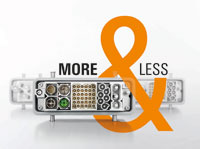
Posted to News on 21st Nov 2017, 00:00
Making the Industry 4.0 connection
What does Industry 4.0 mean to you? Ask 100 people and you’ll probably get 101 different answers, says Ivor Hunt, product marketing specialist, Device Connectivity, of Weidmüller. But one thing that they’re all likely to agree on is that it’s going to need more connections – often a lot more connections.

In principle, terminals are very simple devices. Nevertheless, they play an essential role in almost every automation system and it’s not exactly news that, when it comes to terminals, product quality is always a key requirement. A faulty terminal can stop a plant from functioning just as surely as a faulty PLC or drive. And, since in many applications there may be hundreds or even thousands of terminals and only a few drives and PLCs, it’s perfectly possible that a faulty terminal will be harder to find.
If you’ve read anything, either online or in the press, about Industry 4.0 – and let’s face it, it’s been hard to avoid reading about it – you’re sure to have noticed that enhanced connectivity is one of its foundations. In industrial applications, you’ll read about the collection of data from large numbers of sensors and even from individual devices, such as motor starters and drives, in control systems.
Some of that data will be collected via wireless links but a lot will rely on conventional wired connections, if only because factories tend to be electrically noisy environments, which makes reliably collecting data via wireless from large numbers of devices a challenging task.
The upshot of this is very clear – control panels that are designed to support Industry 4.0 are likely to need even more connections to the outside world than their present-day counterparts. But this could be rather problematic. There’s continual pressure from end users to make control panels smaller; they’re simply seen as a necessary evil that occupies valuable factory floor space, so the smaller they can be made the happier the end users are.
Unfortunately, connections take up space – especially when conventional terminals are used. That doesn’t, of course, mean that terminals are a bad choice – in the right application, they offer an excellent and very versatile way of making connections between, say, a control panel and the plant it’s controlling. When there’s pressure on space, however, and a large number of connections need to be made there’s a better option – the plug-in industrial connectors. These are especially attractive in Industry 4.0 applications where a control panel may well need high-current power connections, high-speed network connections and almost everything in between.
Actually, connectors also support another facet of Industry 4.0, that of easy – and eventually automated – maintenance. It would not be at all surprising if this were implemented by devising modular systems, where the control panel was just another module. In this scenario, it’s easy to see that using plug-in connectors for the control panel would make it a far more easily interchangeable module than if conventional terminals were used.
There is, of course, no shortage of industrial connector options on the market today, but are they all equally suited for use in future-proof systems capable of supporting Industry 4.0 implementations, either immediately or in the future? The answer has to be no, so let’s take a look at some of the features that make a connector system a good choice for designers who are aiming to satisfy not only today’s requirements, but also tomorrow’s.
Starting with the most basic point, the connector system needs to be modular, and it needs to include modules that will cover a comprehensive range of applications. For control panel applications in particular, power modules will be important but, with the growing use of Industrial Ethernet systems, so will modules capable of supporting the latest high-speed network connections.
Versatility is not the only consideration, however. As we’ve already seen, space is another key issue, and this is an area where recent developments mean that there are now big and important differences between the most innovative future-oriented connector systems and the others. For example, modules have traditionally been supplied only in single- and double-width versions, which is fine when those particular sizes happen to suit the application.
But what happens when a single-width module offers more connection points than the application needs or when it offers not quite enough? The answer used to be wasted space in the connector or, in the second case, possibly the need to add another connector shell. With the best of today’s connector systems, these problems are solved, as in addition to single- and double-width modules, they offer half-width and one-and-a-half width modules, ensuring space is used efficiently in every application.
Looking further at the modules, those featured in the latest systems save even more space by offering significantly higher connection densities than their traditional counterparts. For example, with traditional designs it usually takes two single-width modules to provide 24 control connections rated at 250V. The latest systems, however, include double-width modules that take up the same space in the housing yet provide 36 connections – an increase in connection density of 50%, which translates into big space savings.
It’s not just the densities of control connections that are higher in the latest connector systems. High-density power connections are also available, which allow four 100A connections to be accommodated in a 10B housing whereas, with older systems, a much larger 16B housing would be needed. And network connections certainly haven’t been neglected; two connections for CAT 6A cables that support speeds up to 10Gbit/s can now be integrated in a single module. As this module uses standard M12 connector technology, it offers excellent EMC performance, with maximum protection against external interference. These improvements would, of course, be of little value if they had been achieved at the expense of reliability and robust construction, but this is most definitely not the case. Connectors with all of the desirable features discussed are available with modules that are proven to give long, reliable service even in the toughest operating environments, complemented by durable yet lightweight connector shells that can be used in systems where IP65 or even IP68 environmental protection is needed.
Whether you like or loathe the idea of Industry 4.0, there’s no getting away from the fact that it’s going to create a lot of opportunities and just as many challenges. Not the least of the challenges will be handling all of the connections needed for the torrent of data on which Industry 4.0 is based, and implementing those connections in such a way that they support modular system designs, suitable for easy and possibly even automated maintenance.
Fortunately, these connection challenges are tameable, thanks to the latest modular connector systems backed by suppliers like Weidmüller that are committed to ensuring that the fourth industrial revolution really does deliver what it promises.
Klippon House, Centurion Court Office Park
Meridian East, Meridian Business Park
LE19 1TP
UNITED KINGDOM
+44(0)116 282 3470






